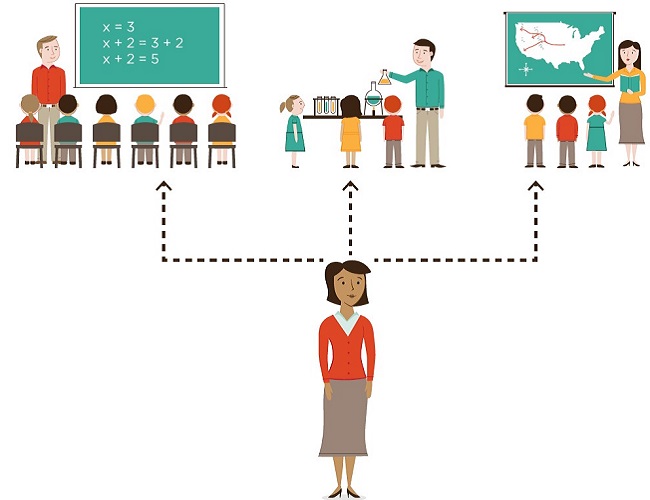
What would happen if schools changed the way they staffed a classroom? What if instead of the traditional method — one teacher leading a classroom — a whole team of teachers were available to support students?
Teacher-led teams are yielding “top-tier results nationally,” according to a press release from Public Impact, the Chapel Hill-based research firm that designed this Opportunity Culture model. More than a decade’s worth of data reveal the model produces additional student learning growth, better educator satisfaction rates, lower turnover and vacancy rates, and growing pay supplements.
“Teacher-led teams are essential to scaling excellent teaching to all students,” said Bryan Hassel, co-president of Public Impact and founder of the Opportunity Culture initiative. “Over 12 years, 10,000 educators in urban, rural, and suburban schools have used their voices to help us get this right for their students.”
![]() Sign up for the EdDaily to start each weekday with the top education news.
Sign up for the EdDaily to start each weekday with the top education news.
How the model works
Each participating school assembles a team of teachers and administrators to design and implement Opportunity Culture roles. The team adjusts the allocation of school budgets to fund salary supplements for educators in these roles.
At the core of the model is the “Multi-Classroom Leader,” a high-performing teacher who leads a small team — often four to five classroom teachers and a paraprofessional, who provides additional support and small-group tutoring.
“The leaders have dedicated time each week for observing and coaching the team, co-teaching, modeling instruction, and leading planning and data analysis,” according to an op-ed by Sharon Kebschull Barrett, a senior vice president at Public Impact, for The 74. “They are accountable for the results of all students taught by members of the team.”
The leaders take on that additional responsibility in exchange for a pay supplement of around 23% above average teacher salary — an average of $13,500 nationally. Other team roles typically receive 3% to 15% more pay.
A dedicated design portal offers guidance and continuing education modules on school redesign, embedded tutoring, and instructional practices, according to the press release. Schools can follow a self-guided design process through the portal or opt for live design support.
The results
According to Public Impact, two third-party studies have shown that students taught by these teacher-led teams make about an extra half-year of additional learning progress annually in reading and math. Teachers who join these teams often start with average effectiveness rates, yet their students’ academic growth surpasses the 75th percentile once team-based teaching begins.
Title I schools that implemented these teacher-led team models across all core subjects for four or more years were 83% more likely to achieve high growth compared to Title I schools without the models during the 2023–24 academic year.
Educator satisfaction with Opportunity Culture has consistently outpaced that of other staffing approaches. In the 2023–24 survey, 80% of all participating educators rated their experience 5 or higher on a 0–10 scale, compared to just 66% of teachers nationally in a 2024 Educators for Excellence survey. Opportunity Culture educators were also nearly twice as likely to give top ratings of 9 or 10.
Districts tracking staffing outcomes have reported sharp declines in teacher vacancies and turnover, according to the press release. For example, in Winston-Salem/Forsyth County, North Carolina, Title I schools using Opportunity Culture models saw teacher turnover fall by 54% over two years.
Eighty sites across 17 states and Washington D.C. have applied these models, reaching more than 225,000 students in 2025–26. Since Opportunity Culture began the initiative, according to the press release, its educators have earned more than $100 million in additional pay.
Recommended reading



